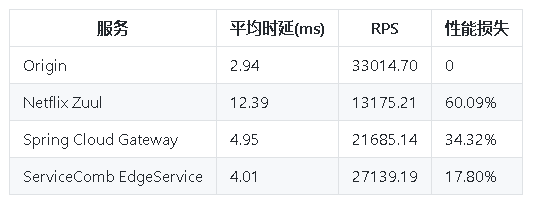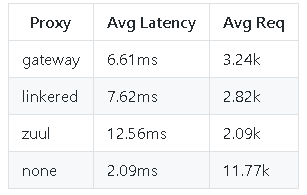【性能测试】三大网关:Spring Cloud Gateway, Zuul, Edge Service 性能对比
本文对几种流行的 API 网关以关键指标 RPS 为依据,利用 wrk 做了性能测评并且给出结论。本文所有使用的软件、命令、以及代码均在文中注明,读者可以很方便地在自己的环境中做出相同的测试。另外性能测试的数据在不同的运行环境中差别较大,但是总体上来说各项数据会成比例变化,本文的测试过程和结论可以较准确地反应出各 API 网关之间的性能差 异。
背景知识介绍
1
API网关
网上有很多关于 API 网关的博客说得很清楚,比如 使用 API Gateway
(https://www.jianshu.com/p/52c2fd448f24) API 网关提供以下的一些功能 :
-
API 最核心的用途是提供系统的唯一入口,类似于设计模式中的 “ 门面模式 ” ,可以在网关层处理所有的非业务功 能
-
封装系统内部架构,为每个客户端提供定制 API
-
还可以提供一些别的功能,如身份验证、监控、负载均衡、缓存、请求分片与管理、静态响应处理等 。
Netflix Zuul

相比较 Spring Cloud Gateway、ServiceComb EdgeService 而言,早在 2013 年之前 Zuul 就已经存在Github项目,在 2013 年进入大众市场并广受欢迎。先发劣势导致当年的 Zuul 还是基于阻塞 io 开发的,在今天看来,性能实在是一般,但是先发优势又让 Zuul 在网关界一直有一席之地 。
2016 年前后基于 NIO 的 Zuul2 开始开发,一直到 2018 年才发布,彼时,市场上类似产品层出不穷, Zuul 已经失去了它的先发优势, Spring Cloud 甚至到现在都没有对 Zuul2 提供支持, Spring Cloud Gateway 等产品的出现和 Zuul2 的频繁跳票,便秘式发布也让 Zuul 走下神坛,逐渐沦落为性能一般,需要被替换的代名词 。
Spring Cloud Gateway

Gateway 建立在 Spring Framework 5 、 Project Reactor 和 Spring Boot 2 上,使用非阻塞 API 。由于它与 Spring 紧密集成,对于开发者而言,成为了一个整合方便、使用方便、高性能的产品 。
其实 Spring Cloud 最开始是整合 Zuul 作为网关解决方案的,但是随着时间的推移, AIO 的局限性不断暴露,据传 Spring 在等待高性能 Zuul 的过程中逐渐失去了耐心,直接导致 Spring Cloud 自己开发了 Spring Cloud Gateway 网关。而这一产品也确实经受住了时间的考验,成为了业界最佳的网关选择之一。回首往事看 Spring 等待 Zuul2 的过程,可以说是塞翁失马,焉知祸福了 。
ServiceComb EdgeService

相比以上的两个网关, EdgeService 知名度显得小很多。但其实 EdgeService 来自于开源项目 apache/servicecomb-java-chassis , ServiceComb 是 在 2017 年 11 月由华为公司 捐献给 Apache 并启动孵化,并于2018 年 10 月 24 日被 Apache 宣布毕业成为 Apache 顶级项目,这也是业界首个在 Apache 孵化并毕业成为微服务顶级项目 。
由于自带微服务场景的基因,所以 EdgeService 天生适用于微服务场景,这一点在后文的配置部分可以很明显地感受的到 。
性能测试
1
环境准备
-
硬件环境:三台机器,分别运行服务端程序,网关程序和压测程 序
-
CPU: 4vCPU Intel(R) Xeon(R) CPU E5-2680 v4 @ 2.40GHz
-
内存: 8GB
-
软件环境:
-
wrk
2
工程文件
本文涉及到的所有代码可从 https://github.com/AngLi2/api-gateway-benchmark 获得(欢迎各位同好 star 关注我啊):

其中 :
-
origin :为本次性能测试的被调用服务文件,测试中在 192.168.0.5:8080 端口启 动
-
zuul: 为 zuul 网关程序,将请求分发到 origin ,测试中在 192.168.0.152:8081 端口启 动
-
使用的 spring-cloud-starter-zuul 版本为 1.4.7.RELEASE ,对应的 Zuul 版本为 1.3.1
-
gateway: 为 gateway 网关程序,将请求分发到 origin ,测试中在 192.168.0.152:8082 端口启 动
-
使用的 spring-cloud-starter-gateway 版本为 2.1.2.RELEASE
-
edgeservice: 为 edgeservice 网关程序,将请求分发到 origin ,测试中在 192.168.0.152:8083 端口启 动
-
使用的 org.apache.servicecomb:edge-core 版本为 1.2.0.B006
3
关键配置
这里展示了多种不同的配置方法,所起到的作用都是一样的,不影响网关的使用和性 能。
Netflix Zuul
通过 application.properties 进行配置 :
zuul.routes.demo.path=/*
zuul.routes.demo.url=http://192.168.0.5:8080
Spring Cloud Gateway
通过 Bean 注入的方式进行配置 :
@Bean
public RouteLocator customRouteLocator(RouteLocatorBuilder builder) {
return builder.routes()
.route(r -> r.path("/checked-out")
.uri("http://192.168.0.5:8080/checked-out")
).build();
}
ServiceComb EdgeService
由于 EdgeService 主要是针对微服务,需要先注册 REST 服务的 endpoint 、接口契约等信息,所以这里的配置稍显复杂,如果直接使用微服务和服务中心,会方便很多 。
1. 根据 REST 接口编写 Java 接口 类
@Path("/checked-out")
@Api(produces = MediaType.TEXT_PLAIN)
public interface Service {
@GET
String getCheckedOut();
}
2. 根据 endpoint 调用方法并且注册 :
String endpoints="rest://192.168.0.5:8080"; RegistryUtils.getServiceRegistry().registerMicroserviceMappingByEndpoints(
"thirdPartyService",
"0.0.1",
Collections.singletonList(endpoints),
Service.class
);
3. 网关配置文件 ( 这里的 loadbalance 只是为了 edgeservice 调用,实际只有一个被调用实例 ) ,这里有一个 maxPoolSize 设置成了 20 ,这个过程是这样的 :
开始没有进行 maxPoolSize 的设置,结果发现用 netstat -apn | grep 192.168.0.5 | grep ESTA | wc -l 来看连接数发现只建立了 20 条连接,参考 ServiceComb 文档 (https://docs.servicecomb.io/java-chassis/zh_CN/transports/rest-over-vertx.html) ,可以看出链接数为 verticle-count * maxPoolSize ,而 maxPoolSize 的默认值只有 5 ,而 verticle-count 的默认值为 :
-
如果 CPU 数小于 8 ,则取 CPU 数
-
如果 CPU 数大于等于 8 ,则为 8
因为测试环境的 CPU 读数为 4 ,所以总链接数只有 4 * 5 = 20 ,而 Spring Cloud Gateway 的总链接数测试的时候一直在 90 多,所以这里将 maxPoolSize 设置成 20 。
事实上,即使在 EdgeService 的链接数为 20 的情况下,测试时也比 Spring Cloud Gateway 链接数 90 的表现要好一点,读者们可以自己尝试一下 。
servicecomb:
rest:
address: 127.0.0.1:8083
client:
connection:
maxPoolSize: 20
http:
dispatcher:
edge:
default:
withVersion: false
enabled: true
prefix: rest
prefixSegmentCount: 2
4
测试过程
原先使用大名鼎鼎的 Apache Benchmark 进行压力测试,结果得出的结论和预期的大相径庭,基于 rxNetty 的 Spring Cloud Gateway 居然比 Zuul 表现还差一大截!而且在进行长连接测试时 Spring Cloud Gateway 直接卡死 。
其实这个问题在 Github 的 spring-cloud-gateway 的 Issues 区早有提及: Throughput problems when compared with Netflix Zuul and Nginx (https://github.com/spring-cloud/spring-cloud-gateway/issues/124)
Issue 被提出是因为有人提出用 Apache Benchmark 对 Spring Cloud Gateway、Netflix Zuul 和 Nginx 进行压测,发现结果如下 :

通过 Issue 的回复区的 : Add support for HTTP 1.0 (https://github.com/reactor/reactor-netty/issues/21) 关联问题,我们可以找到很多关于 rxNetty 不支持 HTTP1.0 的 Issues ,这里列出来几个,有兴趣的读者可以点进去看看 :
-
Add HTTP 1.0 support (https://github.com/ReactiveX/RxNetty/issues/575)
-
Buffering of output in Spring Web Reactive with Netty too aggressive (https://github.com/spring-projects/spring-framework/issues/19510)
-
Add HTTP 1.0 support on Reactor Netty ( Add HTTP 1.0 support on Reactor Netty )
既然得出 Apache Benchmark 并不能很好地测试出网关的性能,转而使用 wrk 进行测试( Spring Cloud Gateway 官方使用的性能测试工具也是这个,后面会有提及)。 wrk 默认工作于长连接模式,有效地减少了断连建连的损耗,可以比较真实地反映出网关的性能 。
对原始服务进行测试
1. 运行命令
wrk -t12 -c100 -d300s http://192.168.0.5:8080/checked-out
2. 得到结果如下 :
Running 5m test @ http://192.168.0.5:8080/checked-out
12 threads and 100 connections
Thread Stats Avg Stdev Max +/- Stdev
Latency 2.94ms 1.18ms 56.41ms 81.59%
Req/Sec 2.76k 228.24 3.76k 72.32%
9906220 requests in 5.00m, 1.25GB read
Requests/sec: 33014.70
Transfer/sec: 4.26MB
3. 根据测试结果,可以得到延时服务的 RPS 和平均延时为 :
-
RPS : 33014.70 请求 / 秒
-
Average Latency: 2.94ms
Netflix Zuul
1. 运行命令
wrk -t12 -c100 -d300s http://192.168.0.5:8081/checked-out
2. 得到结果如下 :
Running 5m test @ http://192.168.0.152:8081/checked-out
12 threads and 100 connections
Thread Stats Avg Stdev Max +/- Stdev
Latency 12.39ms 21.27ms 1.15s 91.90%
Req/Sec 1.10k 264.62 2.09k 72.43%
3953807 requests in 5.00m, 735.99MB read
Requests/sec: 13175.21
Transfer/sec: 2.45MB
3. 根据测试结果,可以得到 Netflix Zuul 的 RPS 和平均延时为 :
-
RPS : 13175.21 请求 / 秒
-
Average Latency: 12.39ms
4. 在性能测试的过程中使用 top 看一下 CPU 使用情况,发现基本上拉满:
Spring Cloud Gateway
1. 运行命令
wrk -t12 -c100 -d300s http://192.168.0.152:8082/checked-out
2. 得到结果如下 :
Running 5m test @ http://192.168.0.152:8082/checked-out
12 threads and 100 connections
Thread Stats Avg Stdev Max +/- Stdev
Latency 4.95ms 9.96ms 539.29ms 98.96%
Req/Sec 1.82k 222.74 2.39k 91.81%
6507221 requests in 5.00m, 850.19MB read
Requests/sec: 21685.14
Transfer/sec: 2.83MB
3. 根据测试结果,可以得到 Spring Cloud Gateway 的 RPS 和平均延时为 :
-
RPS : 21685.14 请求 / 秒
-
Average Latency:4.95ms
4. 在性能测试的过程中使用 top 看一下 CPU 使用情况,发现基本上拉满:
ServiceComb EdgeService
1. 运行命令
wrk -t12 -c100 -d300s http://192.168.0.152:8083/rest/thirdPartyService/checked-out
2. 得到结果如下 :
Running 5m test @ http://192.168.0.152:8083/rest/thirdPartyService/checked-out
12 threads and 100 connections
Thread Stats Avg Stdev Max +/- Stdev
Latency 3.80ms 4.67ms 300.59ms 97.98%
Req/Sec 2.27k 309.82 3.10k 86.53%
8144028 requests in 5.00m, 1.03GB read
Requests/sec: 27139.19
Transfer/sec: 3.52MB
3. 提取 RPS 数据,可以得到 EdgeService 的测试 RPS 为: 27139.19 请 求 / 秒
4. 在性能测试的过程中使用 top 看一下 CPU 使用情况,发现基本上拉满:
5
测试结果
对测试的数据进行表格分析对比后,分别给出平均时延、 RPS 和性能损失((原服务的 RPS - 网关的 RPS ) / 原服务的 RPS ),表格如下图所示 :

从上图可以看出,在硬件环境完全相同,并且 cpu 消耗基本一致的情况下,以 RPS 为性能指标(以性能损失为性能指标的话,差异更大,这里参考业界做法,以 RPS 为指标), ServiceComb EdgeService 的性能是 Netflix Zuul 的两倍多,是 Spring Cloud Gateway 的 1.25 倍多!这还是在 EdgeService 的链接数劣于 Spring Cloud Gateway 20% 左右的情况下的数据,如果将 EdgeService 的链接数设置和 Spring Cloud Gateway 一致,性能会相差更大,有兴趣的读者可以自己尝试一下 。
Spring Cloud Gateway 的性能比 Zuul 好基本上已经是业界公认的了,实际上, Spring Cloud Gateway 官方也发布过一个性能测试: spring-cloud-gateway-bench (https://github.com/spencergibb/spring-cloud-gateway-bench) ,这里节选数据如下 :

因为我们的测试机器部署在同一个局域网,所以性能损失均要低于 spring-cloud-gateway-bench 的测试数据,但是从测试结果看来基本一致。网关的性能和其实现方式也有很大的关系 :
-
Netflix Zuul: 测试版本为 1.x ,基于阻塞 io
-
Spring Cloud Gateway: 前面已经提到过,基于 RxNetty ,异步非阻 塞
-
ServiceComb EdgeService :为 ServiceComb 的子项目,基于 vert.x ,也是异步非阻 塞
同样基于异步非阻塞, EdgeService 的性能明显优于 Spring Cloud Gateway ,可以看出网关的性能不仅和底层实现有关,和内部实现方式和优化也有很大的关系。其实看 ServiceComb 的 官方文档 (https://docs.servicecomb.io/java-chassis/zh_CN) ,可以发现 EdgeService 还支持接入 rest 自动变成 highway 转调,性能更高。这里因为协议层面不一样,就不放出来做对比了,对性能有极致要求的可以采用这种模式 。
在 2018 年终于难产似的发布了 Zuul 2.x 之后, Netflix 给出了一个比较模糊的数据,大致 Zuul2 的性能比 Zuul1 好 20% 左右。然而从测试数据看来就算提升一半也完全打不过 Spring Cloud Gateway ,更不用说 EdgeService 了。看来 Zuul 2.x 并没有把异步非阻塞的性能发挥出来 。
竞争是发展的催化剂。在这个网关服务层出不穷的年代,各公司都铆足力气打造自己的网关产品,尽量让自己的产品成为用户的第一选择。而广大开发者也在享受这样的红利,使用高性能的网关来开发自己的应用。作为广大开发者的一员,我们欣然接受这样良性竞争的出现,并且也乐于尝试市面上出现的任何新产品,谁也说不准某一个产品以后就会成为优选的代名词。虽然从现在网关的性能差距看来,后发优势明显,但在可预见的将来,各网关迟早会到达性能瓶颈,在性能差距不大并且产品稳定之后,就会有各种差异化特性出现。而等到网关产品进入百舸争流的时代之后,用户就可以不再根据性能,而是根据自己的需求选择适合的网关服务了 。
参考资料
-
https://github.com/spring-cloud/spring-cloud-gateway/issues
-
https://github.com/reactor/reactor-netty/issues
-
https://github.com/ReactiveX/RxNetty/issues
-
https://github.com/spring-projects/spring-framework/issues
-
https://github.com/spencergibb/spring-cloud-gateway-bench
-
https://docs.servicecomb.io/java-chassis/zh_CN
-
http://www.itmuch.com/spring-cloud-sum/performance-zuul-and-gateway-linkerd/
-
https://blog.csdn.net/j3T9Z7H/article/details/81025180
-
https://www.zhihu.com/question/67498050
-
https://www.jianshu.com/p/52c2fd448f24
-
https://www.w3xue.com/exp/article/20197/48191.html
1
END

● 可能是国内第一篇全面解读Java现状及趋势的文章
● 持续交付的架构成熟度模型
● Apache ServiceComb Meetup -Shanghai 2019 (PPT Download)

长按二维码加小助手
有趣的灵魂在等你
用心做开源,不忘初心
点个 在看
少个bug


点击下方“阅读原文”查看更多精彩内容☺
- 本文标签: 管理 灵魂 二维码 src bean Spring Boot Reactor java db 产品 时间 list client Service id 缓存 spring 端口 压力 开源项目 需求 Collections build Transport 服务端 AIO rmi 测试 grep 数据 代码 实例 Connection 文章 长连接 zuul 定制 tar 开发者 GitHub HTML 开源 ACE Collection Netflix 2019 协议 UI SDN App 开发 博客 IO Spring cloud 部署 Nginx 负载均衡 配置 Netty CTO REST http NIO bug 微服务 web https map API 设计模式 软件 core ORM 模型 测试环境 apache git cat
- 版权声明: 本文为互联网转载文章,出处已在文章中说明(部分除外)。如果侵权,请联系本站长删除,谢谢。
- 本文海报: 生成海报一 生成海报二











![[HBLOG]公众号](https://www.liuhaihua.cn/img/qrcode_gzh.jpg)

